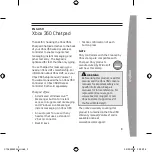
3-
16
3
I/O INTERF
ACE
3-6-2 When executing a dedicated input command
■
The BUSY output signal turns on when a dedicated command is received. Whether the re-
ceived command has ended normally can be checked with the END output signal status at the
point that the BUSY signal turns off. When the END output signal is on, this means that the
command has ended normally. If it is off, the command has not ended normally.
■
The dedicated command input must be a pulse input. If the dedicated command input stays on,
the BUSY signal does not turn off even after the command has been executed.
(1)When a command with a long execution time runs and ends normally:
(Command execution is still in progress and the END signal is off when turning off
(contact open) the dedicated command input.)
Dedicated
command
BUSY
END
30ms or less
1ms or less
1ms or less
(1) At the rising edge of the dedicated command input, the END signal turns off and the BUSY
signal turns on.
(2) Turn off (contact open) the dedicated command input after checking that the BUSY signal
turns on.
(3) Wait until the BUSY signal turns off.
(4) The END signal should be on when the BUSY signal turns off, indicating that the command
has ended normally.
c
CAUTION
In the case of the automatic operation start command (AUTO-R), the END signal turns on and the BUSY signal
turns off when the program ends or a STOP statement is executed. If an endless program (one that automati-
cally returns to the top of the program from the last step) is executed, the BUSY signal will not turn off until an
interlock or emergency stop is triggered.
3-6 I/O Control Timing Charts
Artisan Technology Group - Quality Instrumentation ... Guaranteed | (888) 88-SOURCE | www.artisantg.com
















































